Welcome to my journey through the vibrant world of the peacock bird, where we will uncover their stunning colors and fascinating behaviors. Peacocks are known for their flamboyant feathers that display a mesmerizing range of blues, greens, teals, and turquoise hues. These vibrant colors have inspired artists and designers, influencing fashion trends and home decor.
- Peacock feathers achieve their vibrant colors through structural coloration.
- There are different species of peacocks, including the Indian Blue Peafowl, the Green Peafowl, and the Congo Peafowl.
- Male peacocks display vibrant colors to attract mates and defend their territory.
- Peahens have more muted feathers for nesting and protecting their young.
- Peacock feathers have cultural significance, but ethical questions arise regarding their acquisition.
The Flamboyant Colors of Peacock Feathers
Peacock feathers are renowned for their vibrant colors, which range from stunning blues and greens to mesmerizing teals and turquoise. These feathers have long captivated artists, designers, and nature enthusiasts alike, inspiring awe and admiration for their beauty.
The secret behind the vibrant colors of peacock feathers lies in a phenomenon known as structural coloration. Unlike pigmented colors, which result from the absorption and reflection of specific wavelengths of light, the colors found in peacock feathers are created through the interaction of light with the microscopic structures of the feathers themselves.
When light hits the intricate microstructures of the feathers, it undergoes a process known as interference. This causes certain wavelengths to reinforce each other, resulting in vibrant and iridescent hues. The unique arrangement of these microscopic structures is responsible for the mesmerizing play of colors that can be observed in peacock feathers.

Artists and designers have long been captivated by the rich palette of colors found in peacock feathers. From haute couture runways to home decor, these vibrant hues have made a lasting impression on the world of fashion and interior design. Incorporating peacock-inspired colors into your personal style or living space can add a touch of elegance and vibrancy to any setting.
The Different Species of Peacocks
There are several fascinating species of peacocks, including the Indian Blue Peafowl, Green Peafowl, and Congo Peafowl. Each species possesses its own unique characteristics, captivating both nature enthusiasts and birdwatchers alike.
The Indian Blue Peafowl, also known as the Indian Peafowl or Pavo cristatus, is the most well-known and widely recognized species. The males of the Indian Blue Peafowl boast vibrant blue and green plumage, with long and iridescent tail feathers that form a beautiful train. Their impressive displays are a sight to behold during courtship rituals.
The Green Peafowl, or Pavo muticus, is native to Southeast Asia. It is slightly larger than the Indian Blue Peafowl and possesses an exquisite blend of iridescent green and bronze feathers. The males also display elongated feathers on their back, forming a cape-like structure. Despite their striking appearance, the Green Peafowl is considered endangered due to habitat loss and hunting.
The Congo Peafowl, or Afropavo congensis, is the smallest and least known of the peacock species. It is found in the dense rainforests of Central Africa, particularly in the Democratic Republic of Congo. The males display brilliant blue plumage with unique white and gold markings on their wings. The Congo Peafowl’s elusive nature adds to its allure, making it a prized sighting for birdwatching enthusiasts.
| Species | Scientific Name | Native Region |
|---|---|---|
| Indian Blue Peafowl | Pavo cristatus | South Asia |
| Green Peafowl | Pavo muticus | Southeast Asia |
| Congo Peafowl | Afropavo congensis | Central Africa |
Each species of peacock contributes to the vibrant and diverse world of these magnificent birds. Their captivating colors, intricate patterns, and enchanting displays have fascinated humans for centuries. Whether admiring their beauty in the wild or incorporating their symbolism into various art forms, peacocks continue to capture our imaginations and inspire us with their grandeur.
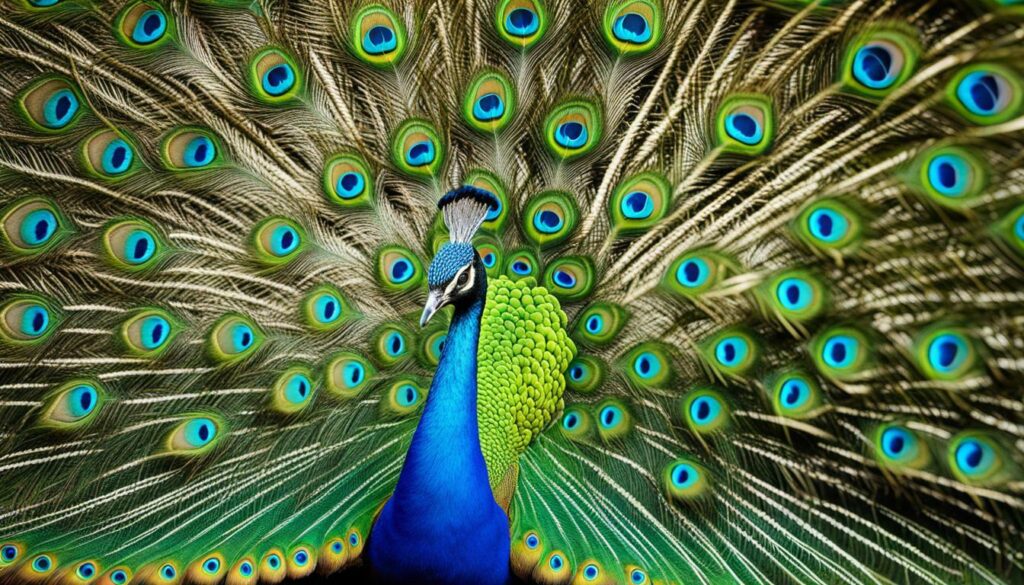
Peacock plumage undergoes a remarkable transformation, with dull chicks ultimately evolving into the radiant adults known for their magnificent feathers. As chicks, peacocks are born with a lackluster appearance, their feathers exhibiting a subdued hue. However, as they mature, their plumage undergoes a captivating metamorphosis, revealing an explosion of vibrant colors.
The gradual development of peacock feathers is a fascinating process that captivates the imagination. These regal birds possess a unique ability to produce structural coloration, which is responsible for the breathtaking array of colors seen in their plumage. This phenomenon occurs when light interacts with the microscopic structure of their feathers, resulting in the scattering and absorption of certain wavelengths of light. The result is a dazzling display of iridescent blues, greens, teals, and turquoise hues that seem to shimmer and change with each movement.
To truly appreciate the transformation, it is essential to witness the mature adult peacock in all its resplendent glory. The distinctive patterns and vibrant shades found in their plumage are a testament to the intricate beauty of nature. From intricate eye spots on their feathers to delicate, cascading patterns, the peacock’s plumage is a work of art in itself.
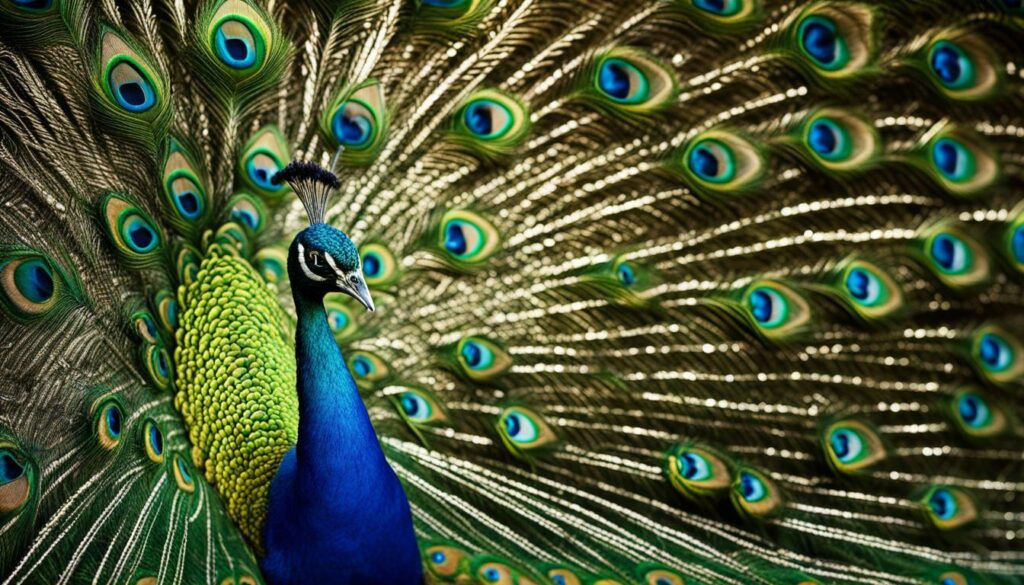
| Species | Characteristic |
|---|---|
| Indian Blue Peafowl | Feathers with iridescent blue and green hues |
| Green Peafowl | Feathers with metallic green and bronze tones |
| Congo Peafowl | Feathers with iridescent purples and blues |
The evolution of peacock plumage not only serves as a visual spectacle but also plays a significant role in the mating rituals of these majestic birds. The vibrant colors of the mature peacock’s feathers are a symbol of genetic fitness and overall health, making them highly attractive to potential mates. Furthermore, these vibrant displays also function as a means of defending their territory, asserting their dominance in the avian hierarchy.
The Significance of Peacock Plumage
Peacock plumage is not only a marvel of nature but has also captured the attention of humans for centuries. The dazzling hues of peacock feathers have inspired artists, designers, and craftsmen alike, who have sought to recreate their beauty in various forms of art and adornment. From exquisite fashion pieces to intricate home decor, the allure of peacock feathers knows no bounds.
“The vivid colors and intricate patterns of peacock plumage have served as a muse for countless artists throughout history.”
In addition to its aesthetic appeal, peacock plumage holds cultural significance in many societies around the world. In some cultures, peacock feathers are believed to bring good luck, prosperity, and protection. They have been used in religious ceremonies, traditional rituals, and even as symbols of royalty. However, it is important to consider the ethical implications of obtaining peacock feathers, as their popularity has led to concerns about the welfare of these magnificent birds.
Peacock plumage is a testament to the diversity and beauty of the natural world. Its vibrant colors, intricate patterns, and remarkable transformation from dull chicks to radiant adults make peacocks a true marvel worth celebrating and cherishing.
The Intricate Body Patterns of Peacocks
In addition to their vibrant feathers, peacocks possess intricate body patterns that add to their captivating appearance. These elaborate patterns, found on their necks, chests, and wings, are composed of delicate and intricate designs. The feathers feature eye-like shapes, known as ocelli, which are actually individual feathers with a dark spot in the center surrounded by a lighter-colored ring. These ocelli are arranged in a stunning pattern, resembling a beautiful mosaic.
These intricate body patterns serve multiple purposes for peacocks. One of their main functions is for attracting mates. The vivid colors and intricate designs create a mesmerizing display during courtship rituals. As the peacock fans out its feathers, the ocelli create a stunning visual effect that is irresistible to potential mates. The more intricate and well-defined the patterns, the more attractive the peacock is to peahens.
Furthermore, these body patterns also play a role in territorial defense. When a peacock feels threatened by an intruder, it will raise its feathers and display its intricate patterns in a show of dominance. The vibrant colors and intricate designs serve as an intimidation tactic to ward off rivals and protect its territory.

The Peacock’s Feathers: A Work of Art
The combination of vibrant colors and intricate body patterns makes the peacock’s feathers a true work of art. They are not only visually stunning but also a testament to the wonders of nature’s design. The structural coloration of the feathers, which is responsible for their brilliant hues, adds another layer of beauty to these magnificent creatures.
| Feather Color | Structural Mechanism |
|---|---|
| Blues and Greens | Microscopic structures on the surface of the feathers reflect and scatter light, producing blue and green hues. |
| Teals and Turquoise | The overlapping microstructures on the feather barbules create interference patterns, resulting in teal and turquoise colors. |
These vibrant hues and intricate patterns have not only inspired artists and designers but have also found their way into various aspects of human culture. From fashion to home decor, the peacock’s colors and patterns have been incorporated to add a touch of vibrancy and elegance.
“The intricate body patterns of peacocks are like paintings created by nature, showcasing the beauty and artistry of their existence.” – [Your Name]
The Importance of Male Peacock’s Display
Male peacocks proudly display their vibrant colors to attract mates and defend their territory. These majestic birds are known for their stunning plumage, which features a dazzling array of blues, greens, teals, and turquoise hues. Their feathers are a testament to the wonders of nature’s color palette and have captivated artists and designers for centuries.
Peacock feathers achieve their vibrant colors through a phenomenon called structural coloration. Unlike pigments, which absorb and reflect certain wavelengths of light, the colors of peacock feathers are a result of intricate microscopic structures that reflect and scatter light. This unique structural arrangement allows the feathers to appear iridescent and change color depending on the viewing angle.
The male peacock’s vibrant display serves multiple purposes. Firstly, it acts as a visual signal to attract potential mates. The vivid colors and elaborate patterns of their feathers are a clear indication of the male’s genetic fitness and overall health. Peahens, the female counterparts, are instinctively drawn to these vibrant displays as they seek the most suitable mate to ensure the survival of their offspring.
Secondly, the vibrant colors also serve as a means of defending the male’s territory. In the presence of a potential threat, such as a rival male, the peacock will fan out his tail feathers to showcase their brilliant hues. This visually striking display serves to intimidate intruders and establish dominance, preventing any encroachment on their chosen territory.
Male peacocks understand the power of their vibrant colors and confidently flaunt their exquisite plumage to attract mates and assert their dominance. It’s a mesmerizing sight that showcases the wonders of nature and reminds us of the incredible diversity and beauty found in the animal kingdom.

| Vibrant Colors of Male Peacock’s Plumage | Attract Mates | Defend Territory |
|---|---|---|
| The vibrant colors of a male peacock’s plumage are a sight to behold. From brilliant blues to mesmerizing greens and teals, their feathers are a marvel of nature’s artistry. | Peacocks proudly display their vibrant colors to attract mates. The ornate patterns and vivid hues are an irresistible allure for peahens, who carefully evaluate potential partners. | The vibrant display of a male peacock’s plumage also serves as a means of defending territory. By showcasing their radiant feathers, they establish dominance and deter rival males from encroaching on their domain. |
I find it fascinating how male peacocks use their vibrant colors to communicate and secure a mate. It’s a testament to the power and beauty of nature.
The Science of Structural Coloration
The vibrant hues of a male peacock’s plumage are not achieved through pigments like most other animals, but rather through a phenomenon called structural coloration. This remarkable process involves the interference and scattering of light by microscopic structures within the feathers, resulting in the stunning iridescent colors that we see.
- The feathers of a male peacock contain microscopic structures that act as prisms, refracting and reflecting light.
- As light passes through these structures, it undergoes interference, resulting in the amplification of certain wavelengths and the suppression of others.
- This selective amplification and suppression of wavelengths give rise to the vibrant colors observed in the male peacock’s plumage.
- The precise arrangement and composition of these feather structures contribute to the variety of colors and patterns displayed by different species of peacocks.
The evolution of such elaborate and vivid plumage in male peacocks is believed to be driven by sexual selection. Females are naturally drawn to vibrant displays, interpreting them as indicators of a male’s genetic fitness, health, and ability to provide for offspring. Thus, the male peacock’s vibrant colors play a vital role in attracting mates and ensuring the continuation of their species.
The Role of Peahens in Nesting and Protection
While male peacocks steal the spotlight with their vibrant plumage, peahens play a crucial role in nesting and protecting their young with their more subdued feathers. These magnificent birds may not boast the same flashy colors as their male counterparts, but their role in the peafowl family is equally important.
Peahens, with their muted feathers of browns and grays, blend in with their surroundings to protect themselves and their offspring from potential predators. These feathers provide excellent camouflage, allowing them to nest and lay their eggs safely. The peahen’s ability to conceal herself in the foliage helps keep her young hidden and increases their chances of survival.
Nesting is a careful and meticulous process for peahens. They construct their nests on the ground, making shallow depressions in the soil or leaf litter. The female peacock lays her eggs in these nests, typically laying one to six eggs at a time. She takes great care in protecting and incubating her eggs for about a month until they hatch.
Once the chicks emerge from their eggs, the peahen continues her essential role as a protector. She diligently watches over her young, guiding them through their early stages of life. The peahen keeps a watchful eye for any potential threats and guides her chicks away from danger. Her nurturing and protective instincts ensure the survival of the next generation of peafowl.
The Role of Peahens in Nesting and Protection
| Role | Description |
|---|---|
| Nesting | Peahens construct nests on the ground to lay their eggs and provide a safe environment for incubation. |
| Protection | With their muted feathers, peahens blend in with their surroundings, providing camouflage and protecting their young from predators. |
| Nurturing | Peahens guide and care for their chicks, ensuring their survival and teaching them essential skills for adulthood. |
While male peacocks mesmerize with their vibrant colors, it is the peahens who work tirelessly behind the scenes to ensure the continued existence of these magnificent birds. Their subtle beauty and dedicated efforts in nesting and protecting their young make them an integral part of the peafowl family.

While Indian Blue Peafowl is the most well-known, there are lesser-known peacock species like the Javanese peacock that possess their own intriguing qualities. The Javanese peacock, also known as the Green Peafowl, is native to Southeast Asia and is renowned for its stunning beauty.
The Javanese peacock features a unique coloration with vibrant hues of green and bronze on its plumage, showcasing nature’s artistic prowess. Its long, flowing tail feathers dazzle with an array of eye-catching patterns, making it a sight to behold. With its elegant stature and regal appearance, the Javanese peacock exudes an air of enchantment and mystery.
While not as widely known, the Javanese peacock’s striking aesthetic makes it a hidden gem among peacock enthusiasts and wildlife lovers. Its rarity and captivating presence make it a symbol of grace and allure. Its intricate patterns and vibrant colors inspire awe and fascination, making it a perfect subject for artists and designers seeking inspiration from the wonders of nature.
| Species | Region | Distinctive Features |
|---|---|---|
| Indian Blue Peafowl | South Asia | Stunning iridescent blue and green plumage |
| Green Peafowl (Javanese peacock) | Southeast Asia | Vibrant green and bronze plumage, intricate patterns |
| Congo Peafowl | Central Africa | Dark blue plumage, distinctive crest |

As we delve into the vibrant world of peacocks, it’s important to appreciate the beauty and diversity of these magnificent creatures. While the Indian Blue Peafowl may be the first image that comes to mind, exploring lesser-known species like the Javanese peacock introduces us to a whole new level of fascination. With their captivating colors, intricate patterns, and unique characteristics, these lesser-known peacock species deserve their moment in the spotlight.
The Cultural Significance of Peacock Feathers
Peacock feathers hold cultural significance and have been used in various aspects of human culture, raising ethical questions along the way. The vibrant colors and intricate patterns of these feathers have captured the imagination of artists, designers, and individuals worldwide.
Their striking hues of blues, greens, teals, and turquoise have inspired creations in the realms of fashion and home decor. From haute couture runways to interior design, peacock feathers have found their place as a symbol of luxury and beauty. Their unique coloration achieved through structural coloration adds an element of mystique and elegance to any setting.
| Peacock Feather Uses in Culture | Symbolic Interpretations |
|---|---|
| Traditional costumes and accessories | Prosperity and good fortune |
| Religious rituals and ceremonies | Spiritual guidance and protection |
| Artistic and literary inspiration | Intuition, immortality, and beauty |
However, the cultural use of peacock feathers also raises ethical questions. The demand for these feathers has led to concerns regarding the welfare and conservation of peafowl populations. Responsible sourcing and alternatives, such as using synthetic materials or supporting sustainable practices, are being explored to ensure the protection of these beautiful birds.
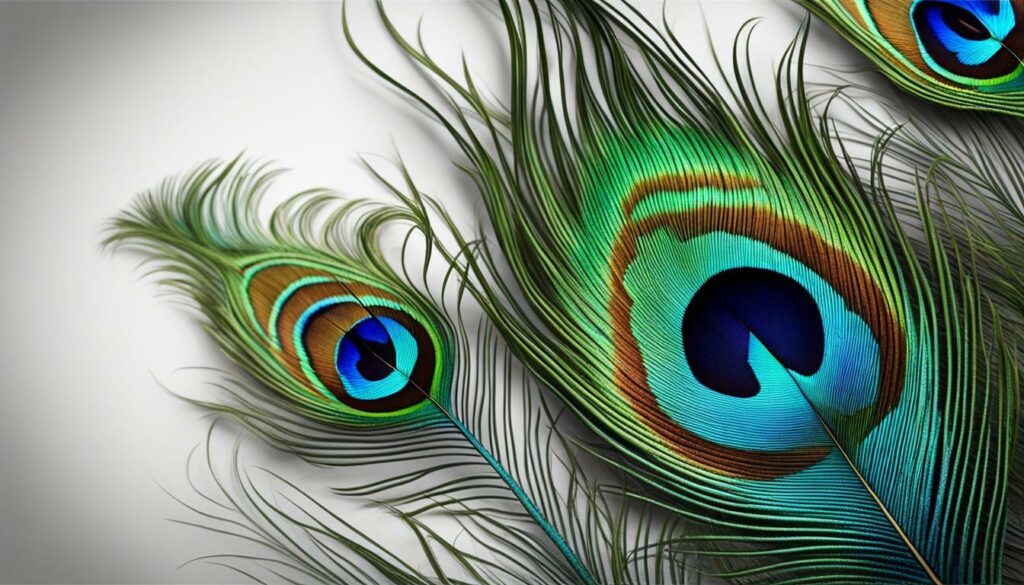
Peacock feathers continue to captivate us with their vibrant colors and intricate patterns. They have left an indelible mark on human culture, inspiring creativity and symbolizing various meanings throughout history. As we appreciate their beauty, it is important to consider the ethical implications and strive for a harmonious coexistence with our feathered friends.
The Sensory Functions of the Peacock’s Crest
The peacock’s crest not only adds to its majestic appearance but also serves important sensory functions in its interactions with the environment. This unique feature, located on top of the peacock’s head, is composed of a collection of long, elegant feathers that can be raised or lowered depending on the bird’s mood or circumstances. The crest plays a vital role in communication, attracting mates, and establishing dominance within the peacock community.
One of the primary sensory functions of the peacock’s crest is its ability to detect subtle changes in air currents. The specialized arrangement of feathers allows the bird to sense even the slightest shifts in the surrounding air, helping it navigate its environment with precision and agility. The crest acts as a sensitive barometer, aiding the peacock in detecting potential threats or opportunities.
Furthermore, the peacock’s crest serves as a visual signal during courtship displays. When a male peacock is attempting to attract a mate, he spreads his vibrant tail feathers and raises his crest in a dramatic display of color and grandeur. The elevated crest acts as a visual indication of the bird’s health, genetic quality, and ability to provide for offspring. It captures the attention of peahens and helps them select the most suitable mate for breeding.

In summary, the peacock’s crest is not only a visually stunning feature but also serves important sensory functions in its daily life. This unique adaptation allows the bird to navigate its environment effectively, attract mates, and establish dominance in the peacock community. The sensory capabilities of the crest contribute to the overall beauty and fascinating behaviors of this iconic bird.
Fascinating Facts and Cultural Reverence for Peacocks
Did you know that peacock feathers have a stunning range of colors, including blues, greens, teals, and turquoise? These vibrant hues have been a source of inspiration for fashion trends and home decor. The structural coloration of peacock feathers gives them their vibrant colors, making them even more captivating.
For male peacocks, their vibrant display serves a dual purpose. The stunning colors of their plumage not only attract mates but also serve as a means of defending their territory. Peahens, on the other hand, have more muted feathers, which provide them with camouflage and protection while nesting and raising their young.
Did you know? The word “peacock” is derived from the Old French word paon, which ultimately comes from the Latin word pavo. The scientific name for the bird is Pavo cristatus.
Peacocks are omnivorous birds, and they eat a variety of plants and animals. Their diet includes insects, small mammals, and reptiles. Peacocks also eat fruits and nuts.
Peacocks are social birds, and they live in small groups called “courts”. A court typically consists of a male peacock and several peahens. The peahens prefer to mate with the male who has the largest and most colorful tail.
Peacocks are polygamous birds, meaning that they mate with more than one partner. A male peacock will often mate with several peahens during the breeding season.
Peacocks usually lay 3-5 eggs at a time. The eggs hatch after 28 days of incubation. The young birds, called “chicks”, are cared for by their mother until they are old enough to fend for themselves.
The lifespan of a peacock is 10-15 years in the wild, and up to 20 years in captivity.
More interesting facts:
– The tail of a male peacock can measure up to 3 feet long.
– The tail feathers of a peacock are hollow, and they contain no bone or muscle.
– Peacocks can fly, but they typically prefer to walk or run.
– Peacocks are not born with their colorful tails. The tail feathers grow in gradually over the course of several months.
– Male peacocks use their tails to attract mates. They will often spread their tail feathers to create a “train” that can be up to 7 feet long.
– When a peacock is not displaying its tail, it usually holds the feathers close to its body in a “fan” shape.
– Female peacocks do not have tails.
– Peacocks are monogamous birds, meaning that they mate with one partner for life.
– Peahens often choose their mates based on the size and color of the male’s tail.
– Peacocks are known to be very vocal birds. They make a variety of sounds, including screams, hisses, and clicks.
– The peacock is the national bird of India.
– In Hinduism, the peacock is associated with the god Krishna.
– In Greek mythology, the goddess Hera is sometimes described as having a peacock as her companion.
– In some cultures, the feathers of the peacock are believed to have magical properties.
Peacock feathers: Cultural significance and ethical questions
The cultural significance of peacock feathers extends across various societies. They have been revered and incorporated into various aspects of human culture, including mythology, folklore, and symbolism. However, obtaining peacock feathers raises ethical questions, as it can involve the harm or exploitation of these magnificent birds.
“The vibrant colors of peacock feathers are truly awe-inspiring.” – Sarah Johnson, Fashion Designer
Peacocks, with their radiant plumage and symbolic meaning, continue to captivate our hearts and minds. From their fascinating facts to their cultural reverence, these remarkable birds remind us of the beauty and diversity found in nature.
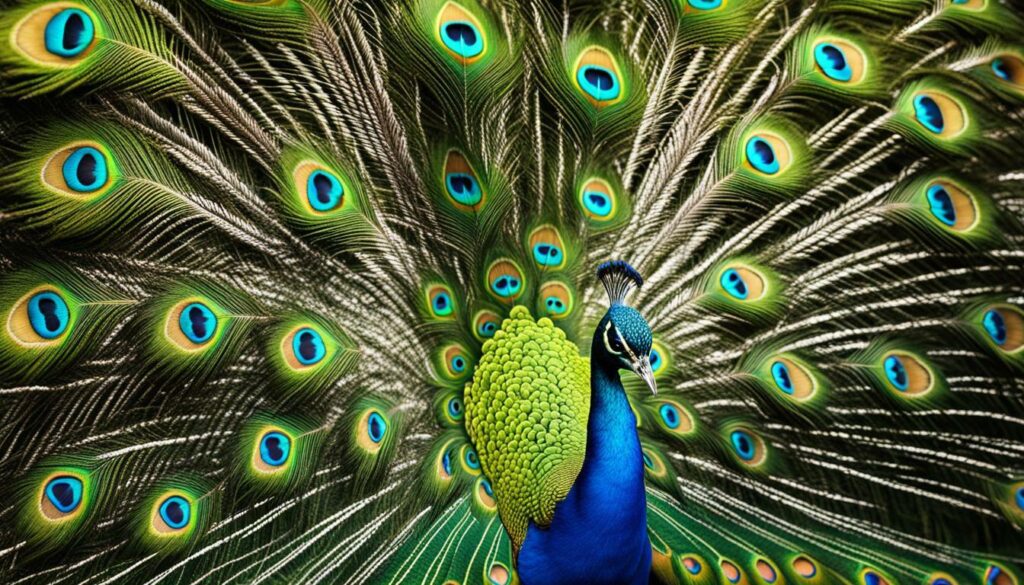
Peacock colors have not only inspired artists and designers, but they have also found their way into home decor and fashion trends. The vibrant hues of peacock feathers can add a touch of elegance and sophistication to any space or outfit. So next time you’re looking for some inspiration, think of the mesmerizing colors of a peacock’s plumage!
Rare Colors and Variations in Peacock Plumage
While the vibrant blues and greens are their signature colors, peacock plumage can sometimes exhibit rare variations, including albino, leucistic, and even charcoal shades. These unique colors add to the allure and mystique of these already fascinating birds.
Albino peacocks, characterized by their pure white feathers, are extremely rare and often considered a symbol of beauty and grace. Their striking appearance stands out against the colorful plumage of their counterparts, captivating the attention of onlookers.
Leucistic peacocks, on the other hand, have partially diluted or faded colors. This genetic condition results in feathers that appear pale or washed-out, creating an ethereal and dreamlike effect. The soft, muted hues of leucistic peacocks add a touch of elegance to their overall appearance.
Another unique variation is the charcoal shade in peacock plumage. This dark and mysterious color is rare and highly sought after for its intensity and depth. The striking contrast between the charcoal feathers and the vibrant hues seen in other parts of their plumage creates a captivating visual display.
| Color Variation | Description |
|---|---|
| Albino | Pure white feathers with no pigmentation |
| Leucistic | Faded or partially diluted colors, creating a pale appearance |
| Charcoal | Dark and intense shades, offering a striking contrast |
“The rare color variations found in peacock plumage, such as albino, leucistic, and charcoal, are captivating and add an element of intrigue to these already magnificent birds.”
These rare colors and variations in peacock plumage demonstrate the incredible diversity and beauty found in nature. They serve as a reminder of how extraordinary and unique every living creature can be.
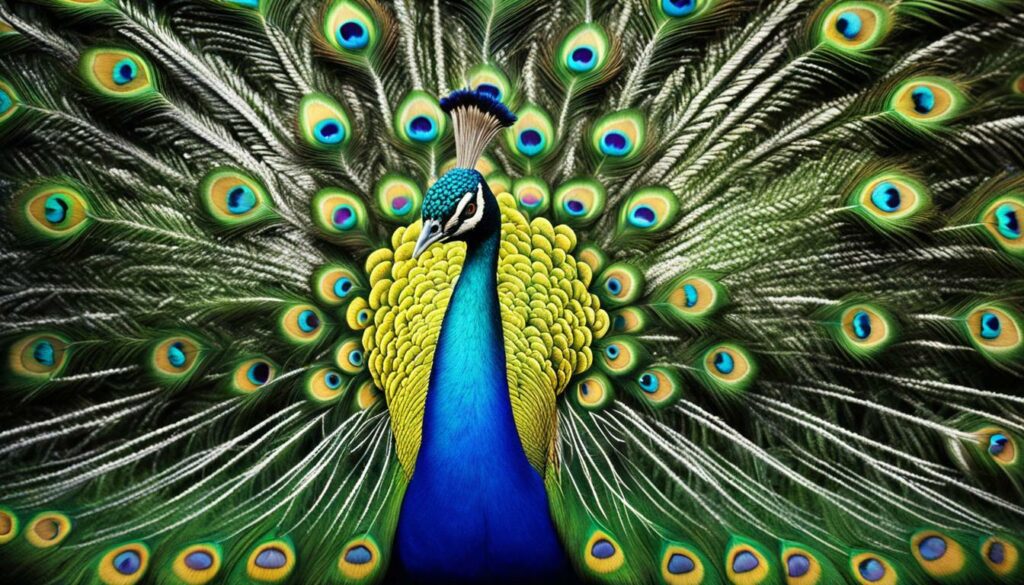
Peacock plumage can exhibit rare variations, including albino, leucistic, and charcoal shades. Albino peacocks have pure white feathers, while leucistic peacocks have partially diluted or faded colors. The charcoal variation showcases dark and intense shades. These rare colors add to the allure and mystique of these fascinating birds, making them even more captivating and unique.
Home Decor and Fashion Inspiration from Peacock Colors
The stunning colors found in peacock plumage have served as inspiration for home decor and fashion, offering a vibrant burst of style. The rich blues, greens, teals, and turquoise hues found in peacock feathers can bring a touch of elegance and opulence to any space or outfit.
When it comes to home decor, peacock-inspired designs can be incorporated in various ways. From accent pillows and throws showcasing the intricate patterns and colors of peacock feathers to wallpaper featuring a bold peacock motif, these elements can transform a room into a captivating and sophisticated space. Additionally, peacock-inspired artwork, such as paintings or sculptures, can serve as striking focal points, adding a touch of whimsy and uniqueness to any interior.
| Peacock-inspired Home Decor Ideas | Description |
|---|---|
| Peacock Feather Wall Clock | Add a touch of elegance to your living room or bedroom with a stylish wall clock adorned with peacock feathers. |
| Peacock Print Bedding Set | Create a luxurious and cozy atmosphere in your bedroom with a peacock-inspired bedding set featuring vibrant colors and intricate designs. |
| Peacock Feather Area Rug | Elevate your space with a plush area rug featuring peacock feather patterns, adding texture and visual interest to your floors. |
| Peacock Feather Throw Pillows | Enhance the comfort and style of your sofa or armchair with a collection of peacock feather throw pillows, showcasing the mesmerizing colors and patterns. |
Peacock colors have also made their mark in the world of fashion, inspiring designers to create stunning garments and accessories. From evening gowns adorned with iridescent feathers to statement jewelry featuring peacock-inspired color combinations, these fashion pieces add a sense of glamour and individuality to any wardrobe. Whether it’s a vibrant peacock blue dress or a pair of earrings with shimmering green and gold accents, incorporating peacock colors into your fashion choices allows you to embrace the beauty and radiance found in nature.
“Peacock feathers have been used in fashion and home décor.”
So, whether you’re looking to revamp your living space or elevate your personal style, don’t hesitate to draw inspiration from the dazzling colors of peacock plumage. Embrace the vibrant allure of peacock colors and watch as your home and fashion choices come to life with a touch of elegance and whimsy.
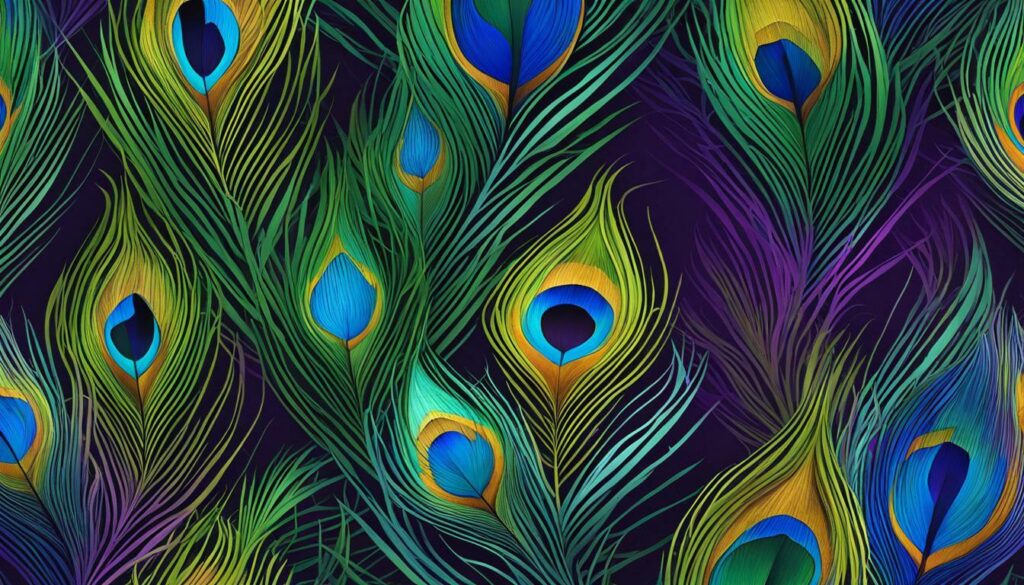
The Union for Conservation of Nature (UCN) and other organizations play a crucial role in the conservation of peacocks, working to protect their habitats and address threats they encounter. Peacocks, with their vibrant colors and intricate patterns, are not only a sight to behold but also an important part of our ecosystem. Through their efforts, these organizations strive to ensure the survival of peafowl species and promote biodiversity.
Peacocks face various challenges in their natural habitats, including habitat loss due to deforestation, illegal hunting for their feathers, and pollution. The UCN works to combat these threats by implementing conservation programs that focus on habitat restoration, anti-poaching measures, and public awareness campaigns.
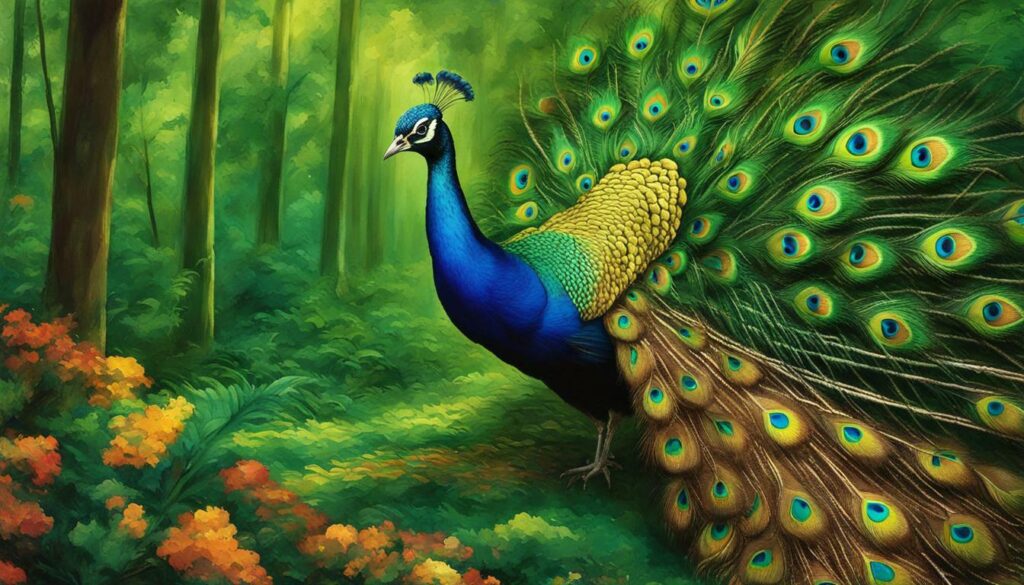
One of the key aspects of peacock conservation is the protection of their breeding grounds. By identifying and preserving these areas, the UCN helps ensure that peafowl have a safe and suitable environment for mating and nesting. They also collaborate with local communities to promote sustainable practices and reduce human-wildlife conflicts, further safeguarding the future of these magnificent birds.
| Threats to Peacock Conservation | Conservation Measures |
|---|---|
| Habitat loss | Implementing habitat restoration programs |
| Illegal hunting | Enforcing anti-poaching measures |
| Pollution | Raising public awareness and promoting sustainable practices |
Peacock conservation is not just about protecting a single species; it is about preserving the delicate balance of our ecosystems. The UCN’s efforts, along with those of other dedicated organizations, are vital in safeguarding the future of peafowl and ensuring that generations to come can continue to marvel at the beauty and wonder of these extraordinary birds.
Ethical Considerations in Obtaining Peacock Feathers
Obtaining peacock feathers raises ethical questions, prompting the need for mindful sourcing and exploring alternatives to preserve the well-being of peafowl. These vibrant feathers have long been coveted for their beauty, and their use in fashion and home decor is widely recognized. However, it is essential to consider the impact of harvesting peacock feathers on the overall welfare of these magnificent birds.
One ethical consideration is the practice of plucking feathers from live peacocks. This inhumane method often leads to pain, distress, and even permanent damage to the birds. Responsible sourcing involves collecting naturally shed feathers or obtaining them from ethical suppliers who prioritize the well-being of their peafowl population.
Exploring alternatives to conventional peacock feathers is another avenue worth considering. Eco-friendly options, like synthetic or faux feathers, offer a cruelty-free alternative without compromising on aesthetics. These alternatives not only alleviate the ethical concerns associated with obtaining peacock feathers but also contribute to the conservation of these remarkable birds.
In summary, when it comes to obtaining peacock feathers, it is crucial to prioritize ethical considerations. By opting for sustainably sourced or synthetic alternatives, we can appreciate the beauty of peacock feathers while ensuring the well-being and conservation of these magnificent birds.

| Ethical Considerations in Obtaining Peacock Feathers | Exploring Alternatives |
|---|---|
|
|
FAQ
What colors are found in peacock feathers?
Peacock feathers have a range of colors, including blues, greens, teals, and turquoise.
How do peacock feathers achieve their stunning colors?
Peacock feathers achieve their stunning colors through structural coloration.
What are the different species of peacocks?
The different species of peacocks include the Indian Blue Peafowl, Green Peafowl, and Congo Peafowl.
How does peacock plumage develop?
Peacock plumage develops from dull chicks to radiant adults.
What are the intricate body patterns found in peacocks?
Peacocks have intricate body patterns that enhance their overall beauty.
Why do male peacocks display vibrant colors?
Male peacocks display vibrant colors to attract mates and defend their territory.
What is the role of peahens in nesting and protection?
Peahens have more muted feathers and are responsible for nesting and protecting their young.
Are there lesser-known peacock species?
Yes, there are lesser-known peacock species, such as the Javanese peacock.
What is the cultural significance of peacock feathers?
Peacock feathers have cultural significance, but obtaining them raises ethical questions.
What functions does the peacock’s crest serve?
The peacock’s crest serves important sensory functions.
What are some fascinating facts about peacocks?
Peacocks have fascinating facts and are revered in different cultures.
Do peacocks have rare colors?
Yes, some peacocks have rare colors such as albino, leucistic, and charcoal.
How can peacock colors be used in home decor and fashion?
Peacock colors can be used as inspiration in home decor and fashion.
What is the Union for Conservation of Nature doing for peacock conservation?
Organizations like the Union for Conservation of Nature are working towards the conservation of peacocks and their habitats.
What ethical considerations should be taken when obtaining peacock feathers?
Ethical considerations should be taken into account when obtaining peacock feathers, ensuring the welfare of peafowl.
What is the significance of peacock colors in nature and culture?
Peacock colors have significance in both nature and culture, impacting their environment and carrying symbolic meaning.

